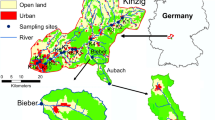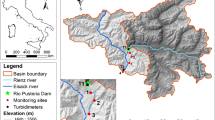Abstract
Spatial and temporal responses of biota to anthropogenic disturbance were measured over a 15 year period in a contaminated stream undergoing remediation and recovery. Along the spatial gradient of the stream, levels of contaminants decreased downstream along with improved responses of instream biota at several levels of biological organization. Recovery of the biota in this stream over the 15 year study period is demonstrated by the temporal relationships between levels of decreasing contaminants and the concomitant responses of the periphyton, macroinvertebrate, and fish communities and changes in the various bioindicators of individual fish health. Decreases in contaminants over a temporal scale were followed closely by an improvement in physiological and organismal-level indicators, increases in the diversity of macroinvertebrate and fish communities, and rapid increases in the chlorophyll a biomass and photosynthesis rate of the periphyton community. These results emphasize that field studies designed to assess and evaluate the effectiveness of restoration activities on stream recovery should incorporate a variety of response endpoints ranging from sensitive and short-term responses to long-term but ecological relevant indicators of change. The close spatial and temporal relationships observed between changes in physicochemical factors and positive responses in various components of the stream biota over the 15-year study period suggest a strong cause and effect relationship between remediation activities and stream recovery. Understanding causal relationships and the mechanistic processes between environmental stressors, stress responses of biota, and the recovery process is important in the effective management and restoration of aquatic ecosystems.
Similar content being viewed by others
References
S.M. Adams (2003) ArticleTitleEstablishing causality between environmental stressors and effects on aquatic ecosystems Human and Ecological Risk Assessment 9 17–35 Occurrence Handle1:CAS:528:DC%2BD3sXitlWjt74%3D
S.M. Adams M.S. Greeley M.G. Ryon (2000) ArticleTitleEvaluating effects of contaminants on fish health at multiple levels of biological organization: extrapolating from lower to higher levels Human and Ecological Risk Assessment 6 15–27 Occurrence Handle1:CAS:528:DC%2BD3cXitVOhsb8%3D
S.M. Adams W.R. Hill M.J. Peterson M.G. Ryon J.G. Smith A.J. Stewart (2002) ArticleTitleAssessing recovery in a stream ecosystem: applying multiple chemical and biological endpoints Ecological Applications 12 1510–1527
T.B. Bagenal F.W. Tesch (1978) Age and growth T. B. Bagenal (Eds) Methods for Assessment of Fish Production in Fresh Waters EditionNumber3 Blackwell Sci. Pubs. Oxford, England 101–136
P. Brant M. Urban N. Goodman S. Bissell I. Spiegal (1999) ArticleTitleStability and resilience in benthic macroinvertebrate assemblages Hydrobiologia 403 123–133
G. Bucolo H. David (1973) ArticleTitleQuantitative determination of serum triglycerides by the use of enzymes Clinical Chemistry 19 476–482 Occurrence Handle4703655 Occurrence Handle1:CAS:528:DyaE3sXkt12guro%3D
F.L. Carle M.R. Strub (1978) ArticleTitleA new method for estimating population size from removal data Biometrics 34 621–630
A. Dawson-Shepherd R.M. Warwick K.R. Clarke B.E. Brown (1992) ArticleTitleAn analysis of fish community responses to coral mining in the Maldives Environmental Biology of Fishes 33 367–380
R.G. Death M.J. Winterbourn (1995) ArticleTitleDiversity patterns in stream benthic invertebrate communities:the influence of habitat stability Ecology 76 1446–1460
M.H. Depledge (1999) ArticleTitleRecovery of ecosystems and their components following exposure to pollution Journal of Aquatic Ecosystem Stress and Recovery 6 199–206
P.W. Detenbeck DeVore G.J. Niemi A. Lima (1992) ArticleTitleRecovery of temperate-stream fish communities from disturbances: a review of case studies and synthesis of theory Environmental Management 16 33–53
K.L. Dickson W.T. Waller J.H. Kennedy L.P. Ammann (1992) ArticleTitleAssessing the relationship between ambient toxicity and instream biological response Environmental Toxicology and Chemistry 11 1307–1322 Occurrence Handle1:CAS:528:DyaK38XlsFOhtr0%3D
Elliott J.M. (1977). Some methods for the statistical analysis of samples of benthic invertebrates. Scientific Publication No. 25, Freshwater Biological Association of the United Kingdom
Environmental Protection Agency (EPA), 1980. Interim methods for the sampling and analysis of priority pollutants in sediments and fish tissues. EPA 600/4-81-055. Environmental Monitoring and Support Laboratory, US Environmental Protection Agency, Cincinnati, Ohio
Environmental Protection Agency (EPA), 1984. Extraction and analysis of priority pollutants in biological tissue, Method PPB 12/83. Environmental Services Division, Region IV, Analytical Support Branch, US Environmental Protection Agency, Athens, Georgia
J. Ford (1989) The effects of chemical stress on aquatic species composition and community structure S.A. Levine M.A. Harwell J. R. Kelley K. D. Kimball (Eds) Ecotoxicology: Problems and Approaches Springer-Verlag New York, NY 99–179
C. Fox (1991) ArticleTitlePractical causal inference for ecoepidemiologists Journal of Toxicology and Environmental Health 33 359–373 Occurrence Handle1875428 Occurrence Handle1:STN:280:DyaK3MzktFyhsQ%3D%3D
R.W. Goede B.A. Barton (1990) ArticleTitleOrganismic indices and an autopsy-based assessment as indicators of health and condition of fish American Fisheries Society Symposium 8 93–108
J.S. Gray K.R. Clarke R.M. Warwick G. Hobbs (1990) ArticleTitleDetection of initial effects of pollution on marine benthos: an example from the Ekofish and Eldfish oilfields, North Sea Marine Ecology Progress Series 66 285–299
J.J. Heinonen K. Kurronen I.J. Holopainen (1999) ArticleTitleThe effects of parasites and temperature on the accumulation of xenobiotics in a freshwater clam Ecological Applications 9 475–481
A.B. Hill (1965) ArticleTitleThe environment and disease: association or causation? Proceedings of the Royal Society of Medicine 58 295–300 Occurrence Handle14283879 Occurrence Handle1:STN:280:DyaF2M%2FovVCmsw%3D%3D
W.R. Hill H.L. Boston (1991) ArticleTitleCommunity development alters photosynthesis-irradiance relations in stream periphyton Limnology and Oceanography 36 1375–1389 Occurrence Handle1:CAS:528:DyaK38XhslSnt7k%3D Occurrence Handle10.4319/lo.1991.36.7.1375
D.A. Holdway (1996) ArticleTitleThe role of biomarkers in risk assessment Human and Ecological Risk Assessment 2 263–267
A. Jearld (1983) Age determination L. A. Nielsen D. L. Johnson (Eds) Fisheries Techniques Southern Printing Co. Blacksburg, Virginia 301–324
R.A. Johnson D.W. Wichern (1992) Applied multivariate analysis for biologists John Wiley & Sons New York, NY
J.R. Karr (1993) ArticleTitleDefining and assessing ecological integrity: beyond water quality Environmental Toxicology and Chemistry 12 1521–1531 Occurrence Handle1:CAS:528:DyaK3sXmtlegtb0%3D
Karr, J. R., Fausch K.D., Angermeier P.L., P. R. Yant & 1.J. Schlosser, 1986. Assessing biological integrity in running waters: a method and its rationale. Illinois Natural History Survey Special Publication 5
J.R. Kelley M.A. Harwell (1990) ArticleTitleIndicators of ecosystem recovery Environmental Management 14 527–545
LMES (Lockheed Martin Energy Systems), 1997. Mercury abatement report for the US Department of Energy Oak Ridge Y-12 Plant for fiscal year 1997, Oak Ridge, Tennessee. Report No. Y/ER-297. Lockheed Martin Energy Systems, Inc., Oak Ridge, Tennessee, USA
L. Maltby (1999) ArticleTitleStudying stress: the importance of organism-level responses Ecological Applications 9 431–440
L.S. McCarty K.R. Munkittrick (1996) ArticleTitleEnvironmental biomarkers in aquatic toxicology: fiction, fantasy, or functional? Human and Ecological Risk Assessment 2 268–274
T. Muotka P. Laasonen (2002) ArticleTitleEcosystem recovery in restored headwater streams: the role of enhanced leaf retention Journal of Applied Ecology 39 145–156 Occurrence Handle10.1046/j.1365-2664.2002.00698.x
P.H. Nienhuis A.D. Buijse E.W. Leuven A.J.M. Smits R.J.W. Nooij Particlede E.M. Samborska (2002) ArticleTitleEcological rehabilitation of the lowland basin of the river Rhine (NW Europe) Hydrobiologia 478 53–72
A.V. Palumbo P.J. Mulholland J.W. Elwood (1987) ArticleTitleExtraction with DMSO to simultaneously measure periphyton photosynthesis, chlorophyll, and ATP Limnology and Oceanography 32 464–471 Occurrence Handle1:CAS:528:DyaL2sXktlKjsbY%3D Occurrence Handle10.4319/lo.1987.32.2.0464
Peterson, M. J. & Phipps T.L., 1995. Bioaccumulation monitoring-aquatic. In Rev. 1: Biological Monitoring and Abatement Program Quality Assurance Plan, QAP-X-90-ES-063. Oak Ridge National Laboratory, Oak Ridge, Tennessee
M.J Peterson G.R. Southworth K.D. Ham (1994) ArticleTitleEffects of sublethal chlorinated discharges on PCB accumulation in transplanted asiatic clams (Corbicula fluminea) Water, Air, and Soil Pollution 73 169–178 Occurrence Handle10.1007/BF00477984 Occurrence Handle1:CAS:528:DyaK2cXisl2mtr4%3D
S.T.A. Pickett J. Kolasa J.J. Armesto S.L. Collins (1989) ArticleTitleThe ecological concept of disturbance and its expression at various hierarchial levels Oikos 54 129–136
J. L. Plafkin (1988) Water quality-based controls and ecosystems recovery J. Cairns SuffixJr (Eds) Rehabilitating damaged ecosystems, Vol. II CRC Press Boca Raton, Florida 87–96
M. Power (1997) ArticleTitleAssessing the effects of environmental stressors on fish populations Aquatic Toxicology 39 151–169 Occurrence Handle10.1016/S0166-445X(97)00020-9 Occurrence Handle1:CAS:528:DyaK2sXmvFWlsr8%3D
M. Power (1999) ArticleTitleRecovery in aquatic ecosystems: an overview of knowledge and needs Journal of Aquatic Ecosystem Stress and Recovery 6 253–257
Railsback, S. F., B. D. Holcomb & Ryon M.G., 1989. A Computer Program for Estimating Fish Population Sizes and Annual Productions Rates. ORNL/TM-11061. Oak Ridge National Laboratory, Oak Ridge, Tennessee, USA
V.H. Resh A.V. Brown A.P. Covich M.E. Gurtz H.W. Li G.W. Minshall S.R. Reice A.L. Shelton J.B. Wallace RC. Wissmar (1988) ArticleTitleThe role of disturbance in stream ecology Journal of the North American Benthological Society 7 433–455
R. C. Rock M. G. Walker C.D. Jennings (1986) Nitrogen metabolites and renal function W. T. Norbert (Eds) Textbook of Clinical Chemistry W. B. Sanders Publishers Philadelphia, Pennsylvania 1271–1273
E.J. Rykiel (1985) ArticleTitleTowards a definition of ecological disturbance Australian Journal of Ecology 10 361–364
SAS Institute, 1996. SAS/STAT User’s Guide, version 6.1. SAS Institute, Gary, North Carolina
Smith, M. R. & Smith J.G., 1995. Biological Monitoring and Abatement Program (BMAP) Benthic Macroinvertebrate Community Studies Quality Assurance Plan. QAP-90-ES-068. Oak Ridge National Laboratory, Oak Ridge, Tennessee, USA
G.R. Southworth (1990) ArticleTitlePCB concentrations in stream sunfish (Lepomis auritus and L. macrochirus) in relation to proximity to chronic point sources Water, Air, and Soil Pollution 51 287–296 Occurrence Handle1:CAS:528:DyaK3cXmtFOlsLw%3D
N.C. Watanabe S. Harada Y. Komai (2000) ArticleTitleLong-term recovery from mine drainage distrubance of a macroinvertebrate community in the Ichi-Kawa River, Japan Hydrobiologia 429 171–180 Occurrence Handle10.1023/A:1004027201667
D.A. Wolfe (1996) ArticleTitleInsights on the utility of biomarkers or environmental impact assessment and monitoring Human and Ecological Risk Assessment 2 245–250
J.D. Yount G.J. Niemi (1990) ArticleTitleRecovery of lotic communities and ecosystems following disturbance: theory and application Environmental Management 14 515–762
C. Zippin (1956) ArticleTitleThe removal method of population estimation Journal of Wildlife Management 22 82–90
Author information
Authors and Affiliations
Corresponding author
Additional information
An erratum to this article is available at http://dx.doi.org/10.1007/s10750-005-6800-8.
Rights and permissions
About this article
Cite this article
Adams, S.M., Ryon, M.G. & Smith, J.G. Recovery in diversity of fish and invertebrate communities following remediation of a polluted stream: investigating causal relationships. Hydrobiologia 542, 77–93 (2005). https://doi.org/10.1007/s10750-004-3951-y
Issue Date:
DOI: https://doi.org/10.1007/s10750-004-3951-y




